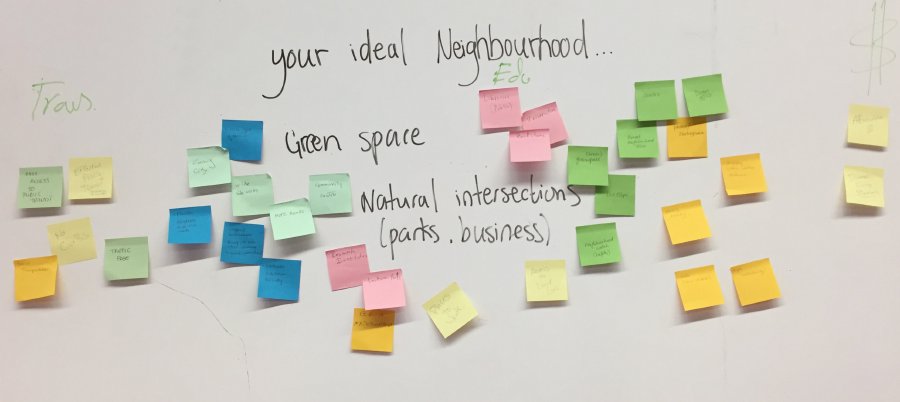Plant a Home Co-Design Session: Empowering Independent Living in the Neighbourhood
The IDRC partnered with Plant a Home to hold a co-design session on September 16th from 1:00-5:00pm at 49 McCaul Street, Toronto. Two representatives from Plant a Home facilitated the session with nine participants from Toronto, Woodstock, and London. Plant a Home is a social enterprise based in London Ontario that seeks to provide independent, long-term housing for adults with developmental disabilities.
Activity Overview
The theme of this session was Empowering Independent Living in the Neighbourhood. How can we design the surrounding neighbourhood to make the home more inclusive within the community? The objectives from this co-design sessions are first, create selection criteria for the location of Plant a Home houses. Second, determine possible aspects of an inclusive neighbourhood to incorporate into new communities through working with developers and city planners. Activities included group discussions on three specific aspects of a neighbourhood: neighbourhood parks, streets and intersections, access to transportation.
Warm Up Discussion
What is an ideal neighbourhood to you?
Image description for the ideal neighbourhood whiteboard
Participants contributed and organized their ideas of the ideal neighbourhood on a white board.
Group Discussions
Then the group discussed the following questions:
1. Neighbourhood Parks
- What are the uses and importance of a neighbourhood park for you and your community?
- What are the consequences to you and your community if this park was removed?
- Think of and share challenges you have experienced accessing or using a neighbourhood park.
- How can neighbourhood parks be built or changed to improve your experience?
2. Streets & Intersections in the neighbourhood
- What things do you normally rely on to navigate streets on your way home?
- Think about and share challenges you experienced navigating streets in your neighbourhood?
- Think about and share some positive experiences you had receiving support from others in your community navigating streets in your neighbourhood.
- How can streets and/or intersections in your neighbourhood be built or changed to help you
3. Access to transportation from your home
- List the detailed steps you need to take to travel around the city from your home.
- Think about and share the barriers you face traveling around the city from your home?
- Think about and share times when it was easy for you to travel around the city from your home?
- How can existing transit options in your neighbourhood be improved, or new transit options be created to better meet your needs?
Results
Three ideals for location selection:
1. Safety
A big barrier to inclusive housing is safety. This includes statistics such as crime rate, vehicle accidents, as well as perceptions of safety for a new home owner. The physical layout of streets, available signage also contributes to a feeling of safety. An idea suggested is to have emergency contact booths spread out around the neighbourhood.
2. Openness to inclusive living
An important step to selecting a housing location is to understand how the existing home owners will respond to a new neighbour with disability. From there, we can find the “do-ers” and “champions” of diversity in the neighbourhood and work with them to promote inclusive living. It is vital for Plant a Home to create a strong communication strategy before building a home and allowing people with disabilities to move into an existing neighbourhood. This includes educating the neighbours about the benefits of inclusive living and being open to hearing feedback.
3. Diversity
The ideal neighbourhood also includes diversity in home owners and diversity in physical housing layouts. Home owners should vary in income levels, background, age, and abilities. This is a neighbourhood with low-income and luxury housing, with single detached housing, and condos, and apartments. This is a neighbourhood with schools for children and assisted-living accommodations for the elderly and those with disabilities. This is a mixed-housing neighbourhood where the elderly, children, students, professionals, and people with disabilities live alongside and support one another. The communication strategy discussed in the previous section is essential to achieving this ideal.

